The Black Horse Trail with the B.E.F. August 1914 - December 1914

France 1914 - 100 Years - RE visited 2014


7 Field Company Royal Engineers
Page 1 of 7 Field Company War Diary 1914 with the first entry on 5 August 1914
warning the Company to mobilize as part of the British Expeditionary Force.
warning the Company to mobilize as part of the British Expeditionary Force.
Entries from War Diary page on left reads:
5 Aug First day of mobilization
6-9 Aug Mobilization proceeded normally except for horses required to complete which could not be obtained till the 8th and following day
10-12 Aug Company did route marches, pontooning etc
18 Aug Entrained and left Shorncliffe at 1035 pm
19 Aug Reached Harrow, detrained by 5 am and marched to Stanmore Camp
20 Aug Route marches, erecting troughs for 10th Bde
21 Aug Entrained and left Harrow station at 1025 pm
War Diary follows on to page 2:
22 Aug Arrived Southampton 2.15 am, embarked on SS ALGERIAN & sailed at 8 am. Headquarters RE, 4TH Division, & HQs + 1 section of signal company also onboard. Left England with full complement of men but short of 2 horses owing to sickness etc enroute. Arrived Havre in afternoon. Anchored
5 Aug First day of mobilization
6-9 Aug Mobilization proceeded normally except for horses required to complete which could not be obtained till the 8th and following day
10-12 Aug Company did route marches, pontooning etc
18 Aug Entrained and left Shorncliffe at 1035 pm
19 Aug Reached Harrow, detrained by 5 am and marched to Stanmore Camp
20 Aug Route marches, erecting troughs for 10th Bde
21 Aug Entrained and left Harrow station at 1025 pm
War Diary follows on to page 2:
22 Aug Arrived Southampton 2.15 am, embarked on SS ALGERIAN & sailed at 8 am. Headquarters RE, 4TH Division, & HQs + 1 section of signal company also onboard. Left England with full complement of men but short of 2 horses owing to sickness etc enroute. Arrived Havre in afternoon. Anchored
Below: 26 August 1914 - 7 Field Company RE join the retreat from Mons
27 Aug
26 Aug. Arrived at St Quentin at 8am. In sidings until 3.45 pm. Trained back to Noyon arriving at 6pm. In sidings all night. Two men missing on leaving St Quentin
27 Aug. Detrained and marched to Cavalry Barracks arriving 11am. Major Faber, Lts Wright & Gourlay with 7 NCOs went to Ham to assist in preparation of a defensive position. They rejoined during the night except 3 NCOs
28 Aug. Two Pontoon wagons + Trestle wagons left at 8.30 for Compiegne to join bridging wagons of other Companies there. Lt Macready and party of three made a reconnaissance of bridges near Sempigny, Varesnes etc for demolition. Company marched at 3.30 pm to Sempigny to join HQs Div’ Engineers, 4th Signal Co RE and 9th Field Co there. Three NCOs joined from Ham. One man more missing on leaving Noyon.
29 Aug. Orders received through CRE. about midday to prepare three bridges ( two over canal and one over river Oise) between Pont d’leveque and Sempigny for demolition. Work continued during the night
30 Aug. Bridges ready for demolition early. Company (except demolition parties) marched 5 am with 10th Brigade. Orders for demolition are attached. During the demolition of the last bridge, a stone one over the river, Lt Gourlay RE & party were fired on by Uhlans who at first were on the far bank but subsequently crossed into Sempigny. The 9th Lancers were providing the covering party but did not detect the approach of the enemy. The demolition party escaped on bicycles & on 9th Lancer horses but two men were found missing (believed dead as they were wounded), Sappers 11760 Coleman and 10519 Butler. A tool cart bolted and was lost. Company bivouacked at Cuise Lamotte about 11 pm.
31 Aug. Company marched to Verberie start at 8.30 am finished march 9.30 pm marching in a long column with numerous lengthy checks.
27 Aug. Detrained and marched to Cavalry Barracks arriving 11am. Major Faber, Lts Wright & Gourlay with 7 NCOs went to Ham to assist in preparation of a defensive position. They rejoined during the night except 3 NCOs
28 Aug. Two Pontoon wagons + Trestle wagons left at 8.30 for Compiegne to join bridging wagons of other Companies there. Lt Macready and party of three made a reconnaissance of bridges near Sempigny, Varesnes etc for demolition. Company marched at 3.30 pm to Sempigny to join HQs Div’ Engineers, 4th Signal Co RE and 9th Field Co there. Three NCOs joined from Ham. One man more missing on leaving Noyon.
29 Aug. Orders received through CRE. about midday to prepare three bridges ( two over canal and one over river Oise) between Pont d’leveque and Sempigny for demolition. Work continued during the night
30 Aug. Bridges ready for demolition early. Company (except demolition parties) marched 5 am with 10th Brigade. Orders for demolition are attached. During the demolition of the last bridge, a stone one over the river, Lt Gourlay RE & party were fired on by Uhlans who at first were on the far bank but subsequently crossed into Sempigny. The 9th Lancers were providing the covering party but did not detect the approach of the enemy. The demolition party escaped on bicycles & on 9th Lancer horses but two men were found missing (believed dead as they were wounded), Sappers 11760 Coleman and 10519 Butler. A tool cart bolted and was lost. Company bivouacked at Cuise Lamotte about 11 pm.
31 Aug. Company marched to Verberie start at 8.30 am finished march 9.30 pm marching in a long column with numerous lengthy checks.
To get a good understanding of the situation at this time, view this clip, Line of Fire - The retreat from Mons (48.40 mins)
https://www.youtube.com/watch?v=kl0GzdcUde0
https://www.youtube.com/watch?v=kl0GzdcUde0
August 1914. Pioneer Daniells of 7 Field Company wrote this in his diary:
27 August. Whilst at the camp the Company witnessed our infantry returning, never more than a hundred per party.
They were absolutely dead beat, boots worn out, unshaven and dirty. The officers were in the same state.
Each contingent returning would make for the riding school, flop down and immediately fall asleep.
29 August. Reveille at 5am. Men take a bath in the canal. Arms inspection at 9.30am. Troops are passing through all day. News comes in that a Major in 9th Company has been killed. A French plane brings down a German plane after a short struggle
27 August. Whilst at the camp the Company witnessed our infantry returning, never more than a hundred per party.
They were absolutely dead beat, boots worn out, unshaven and dirty. The officers were in the same state.
Each contingent returning would make for the riding school, flop down and immediately fall asleep.
29 August. Reveille at 5am. Men take a bath in the canal. Arms inspection at 9.30am. Troops are passing through all day. News comes in that a Major in 9th Company has been killed. A French plane brings down a German plane after a short struggle
At this point 7 Field Company joined the retreat from Mons
The Company trail 1-10
September was mainly marching and bivouacking. At Dammartin the Company improved the water supply before moving on.
On 6th September the retreat turned into an advance. 7 Coy were with 11th Bde who were at this time and for the next few days acting reserve for 4th Division, which in turn was in support of the 1st Army directly engaged with the enemy to the east.
At La Ferte sous Jouarre the Company built a Pontoon Bridge together with 9 Field Company over the River Marne 9/10 Sep 1914.
On the 10 September the Coy manned the bridge all day.
11 Sep the Company dismantled the bridge.
September was mainly marching and bivouacking. At Dammartin the Company improved the water supply before moving on.
On 6th September the retreat turned into an advance. 7 Coy were with 11th Bde who were at this time and for the next few days acting reserve for 4th Division, which in turn was in support of the 1st Army directly engaged with the enemy to the east.
At La Ferte sous Jouarre the Company built a Pontoon Bridge together with 9 Field Company over the River Marne 9/10 Sep 1914.
On the 10 September the Coy manned the bridge all day.
11 Sep the Company dismantled the bridge.
The long retreat comes to an end 6th September 1914, The Allies counter attack at the Marne and push the once unstoppable Germans back to the north side of the River Aisne
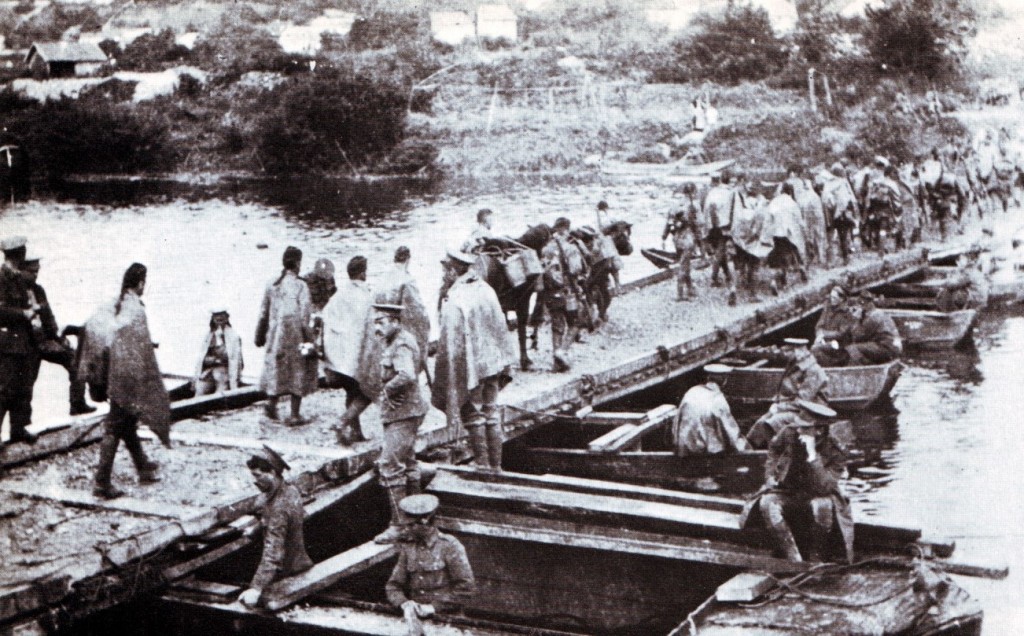
The Marne Pontoon Bridge.
Built by the 7th and 9th Field Companies RE 9/10 Sep 1914 at La Ferte sous Jouarre
Built by the 7th and 9th Field Companies RE 9/10 Sep 1914 at La Ferte sous Jouarre
7 Field Company can be seen manning the bridge on the 10th September as two French Cavalry Regiments and 4 Division cross
Left: The blown bridge can be seen in the background
On the 11th September 7 Coy stripped the bridge.
Right: Plan of the Marne Pontoon Bridge at La Ferte sous Jouarre
The plan copied from 9 Field Company War Diary Sep 1914
The plan copied from 9 Field Company War Diary Sep 1914
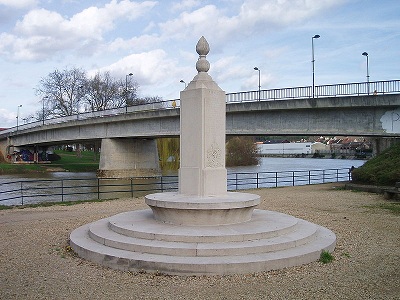
At each side of the river where the Pontoon Bridge crossed,
stands a memorial dedicated to 4 Division Royal Engineers
who built the bridge.
They were erected by the French in appreciation
of this occasion
stands a memorial dedicated to 4 Division Royal Engineers
who built the bridge.
They were erected by the French in appreciation
of this occasion
Above & left: South side memorial
On each memorial, one side is engraved in English and the other side is engraved in French.
Above and below: The south side memorial
100 Years - 9/10 September 1914 - 10 September 2014. Wreaths laid to commemorate the courage and sacrifice of our forebears in WW1 1914-1918
You Tube one minute clip of the wreath laying ceremony at the Royal Engineers memorial 10 September 2014
Please click on the link
https://www.youtube.com/watch?v=pFtbcKyp6eM&feature=youtu.be
Please click on the link
https://www.youtube.com/watch?v=pFtbcKyp6eM&feature=youtu.be
Chris lays a wreath to the missing on behalf of the Shiny Seven Association
The Shiny Seven Association wreath
No sooner had we laid the wreath when the chap pictured above came over and secured the wreath to the stand. He very proudly explained that he looks after the memorials
At each cemetery we visited we planted a poppy cross
and left a couple of the above cards
and left a couple of the above cards
The advance from the Marne to the Aisne
10 September: 2 Brigades of infantry, 1 French Cavalry Brigade and the 4th Division train crossed the Pontoon Bridge
Following the dismantling of the Pontoon bridge on the Marne, the Company advance to the River Aisne, bivouacking in small villages’ en route. On the 13th September in the early hours the Company had breakfast in a small village 1 mile north of Rozieres and together with 9 Field Company marched to Venizel via Billy, after being delayed for a while taking cover from shell fire they proceeded to build a pontoon bridge over the Aisne 50 yards west of the Venizel permanent bridge that was partially blown. 9th Company also did a temporary repair on the main bridge enabling it to be used by light traffic. 7 Company withdrew at 3.30 pm and bivouacked at Vignolles, a village 2 miles south of Soissons.
Above: Diagram of the Venizel Pontoon Bridge.
Courtesy 9 Field Company War Diary September 1914
Courtesy 9 Field Company War Diary September 1914
7 Coy attempted to build a heavy Pontoon Bridge across this gap on 14 September 1914 but had to withdraw due to Howitzer fire.
The pontoons were safely recovered in the evening
The pontoons were safely recovered in the evening
Vignolles 7 Coy bivouacked here evening of 13 September 1914
Chris & I drove through Vignolles several times
Chris & I drove through Vignolles several times
We planted a poppy cross on the near bank
7 Field Company War Diary reads:
14 Sep 1914. Paraded at 7.30 am and attempted bridge River Aisne at Soissons. Prevented by fire from a heavy battery and gave up the attempt at 1 pm. Withdrew to Vignolles.
14 Sep 1914. Paraded at 7.30 am and attempted bridge River Aisne at Soissons. Prevented by fire from a heavy battery and gave up the attempt at 1 pm. Withdrew to Vignolles.
7 Field Company War Diary reads:
15 Sep 1914. Paraded at 9.30 and marched to Venizel. No1 Section took over control of floating bridge. The other 3 Sections were allotted to the 3 Brigades but were concentrated at St Marguerite and undertook work from 8 pm to 1 am in connection with defences half a mile north of the village. Work was interrupted at 11 pm for half an hour by an attack on the east flank. No casualties. HQ of the Company remained in Venizel.
16 Sep 1914. An attempt was made at 8 am to send regimental transport into St Marguerite from Venizel but it was stopped by shell fire and rations were brought up by mounted orderlies. Paraded at 8 pm Nos 2 and 4 sections to work with the Inniskillings and No 3 section to work with the Kings Own. No 1 section remained on the bridge at Venizel, which was shelled without damage during the morning.
15 Sep 1914. Paraded at 9.30 and marched to Venizel. No1 Section took over control of floating bridge. The other 3 Sections were allotted to the 3 Brigades but were concentrated at St Marguerite and undertook work from 8 pm to 1 am in connection with defences half a mile north of the village. Work was interrupted at 11 pm for half an hour by an attack on the east flank. No casualties. HQ of the Company remained in Venizel.
16 Sep 1914. An attempt was made at 8 am to send regimental transport into St Marguerite from Venizel but it was stopped by shell fire and rations were brought up by mounted orderlies. Paraded at 8 pm Nos 2 and 4 sections to work with the Inniskillings and No 3 section to work with the Kings Own. No 1 section remained on the bridge at Venizel, which was shelled without damage during the morning.
Pioneer Jeffery Daniels (7 Coy) Diary reads:
14 Sep 1914. After waking up at 5 am in pools of water we are detailed in parties. I am the General's orderly, my work consists of showing the pontoon drivers the way to the river. Shells are dropping all over the place, a piece dropped not 6ft from me so I retired to a doorway and none too soon, for had I stopped where I was I should no doubt have been in little pieces! The Coy had to give up the attempt to put up a bridge as the Germans had observed us making the bridge and heavily shelled the position. We retired to a goods yard warehouse, where 16 men are told off to recover the pontoons at night, which was safely done.
We had a message read to us from the General congratulating us on the bridge over the Marne.
14 Sep 1914. After waking up at 5 am in pools of water we are detailed in parties. I am the General's orderly, my work consists of showing the pontoon drivers the way to the river. Shells are dropping all over the place, a piece dropped not 6ft from me so I retired to a doorway and none too soon, for had I stopped where I was I should no doubt have been in little pieces! The Coy had to give up the attempt to put up a bridge as the Germans had observed us making the bridge and heavily shelled the position. We retired to a goods yard warehouse, where 16 men are told off to recover the pontoons at night, which was safely done.
We had a message read to us from the General congratulating us on the bridge over the Marne.
Pioneer Jeffery Daniels Diary reads:
15 Sep 1914. We leave Soissons at 8.30 am to return to 11th Infantry Brigade. We cross the Aisne and advance in extended order towards Bucy-le-Long but have to retire on account of heavy shelling on the left. We once more set off but more to the right towards St Marguerite, and are successful in reaching Brigade Headquarters. We have dinner under cover of a church at St Marguerite, we see several wounded taken into the church which is being used as a hospital. The Kings Own borrow our shovels to dig graves. After resting a while we go up a dark muddy lane the hill with pick and shovel full marching order, it is pouring torrents. When we had dug 2ft down we were surprised by German rifle fire, so down we had to lay in our trench. We eventually finish and scramble back to the village. We found shelter in a small room, it was almost as bad as the Black hole of Calcutta, we laid down or rather sat down and went to sleep wet and hungry.
15 Sep 1914. We leave Soissons at 8.30 am to return to 11th Infantry Brigade. We cross the Aisne and advance in extended order towards Bucy-le-Long but have to retire on account of heavy shelling on the left. We once more set off but more to the right towards St Marguerite, and are successful in reaching Brigade Headquarters. We have dinner under cover of a church at St Marguerite, we see several wounded taken into the church which is being used as a hospital. The Kings Own borrow our shovels to dig graves. After resting a while we go up a dark muddy lane the hill with pick and shovel full marching order, it is pouring torrents. When we had dug 2ft down we were surprised by German rifle fire, so down we had to lay in our trench. We eventually finish and scramble back to the village. We found shelter in a small room, it was almost as bad as the Black hole of Calcutta, we laid down or rather sat down and went to sleep wet and hungry.
Field Marshal Sir John French's second Despatch from the BEF in 1914:
http://ukga.org/ww1/28942-2.html
http://ukga.org/ww1/28942-2.html
Today, St Marguerite is a quiet, peaceful, and picturesque village, far removed from the horrors that took place there in WW1
7 Field Company remained in this area until the 5 October 1914, mainly working on improving the trenches. A good deal of time was used gathering barbed wire from farms and wood from buildings. Tools were also acquired from farms to dig and extend the trenches that became necessary for defence, as the mobile warfare came to an abrupt end.
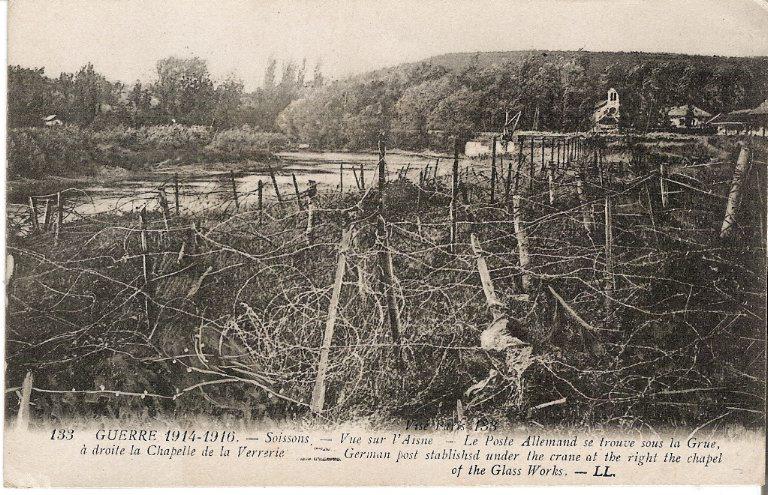
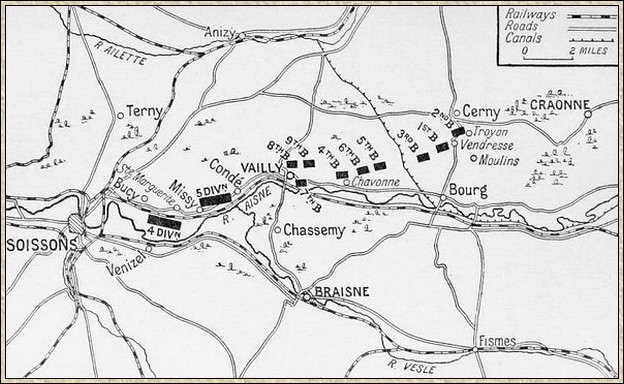
Soissons wrecked Cathederal
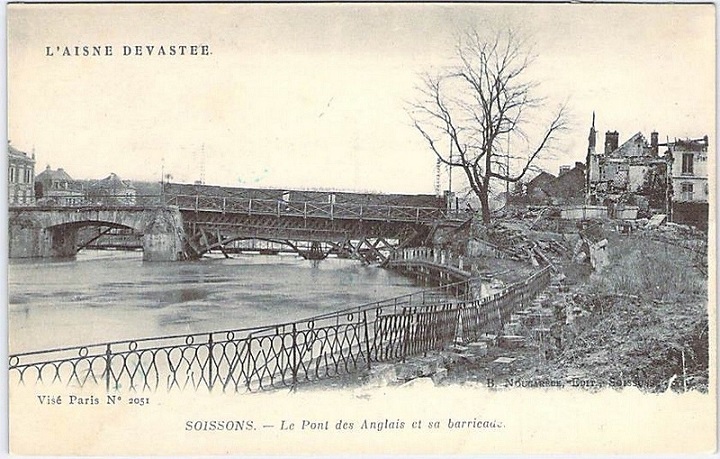
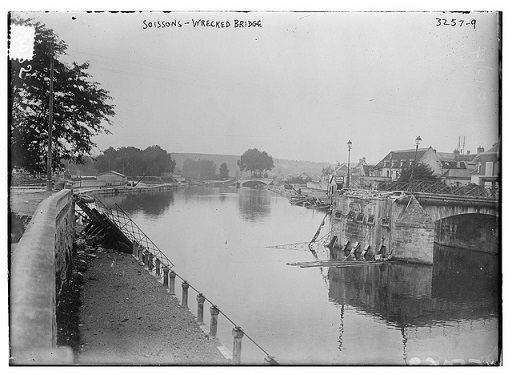
Above: The positions of the BEF on the advance to the Aisne
Left: bridge repair in Soissons was carried by a section from 9 Field Company RE under Lt. L. Martel RE, October 1914. A new pedestrian bridge stands there today and is still known as the "Englishman's" Bridge.
Left: bridge repair in Soissons was carried by a section from 9 Field Company RE under Lt. L. Martel RE, October 1914. A new pedestrian bridge stands there today and is still known as the "Englishman's" Bridge.
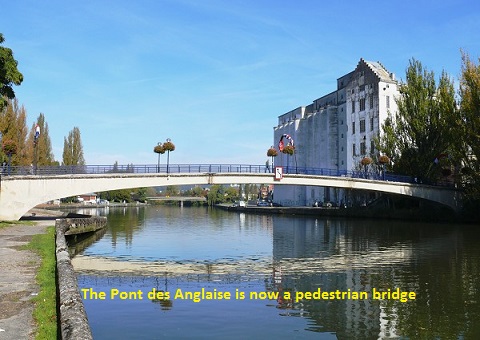
Link to The Middlesex Regiment's accounts of the Battles of the Marne and Aisne 1914:
The Long Long Trail: http://www.1914-1918.net/4div.htm
Interesting Links:
The memorial is fenced off. At the gate there is a telephone number to call to obtain the code for access to the site.
I called and had problems getting through, we therefore stuck a poppy cross on the inside railing as did others before us.
On the centenary year of 1918 we will lay a wreath on the Memorial and possibly earlier.
I called and had problems getting through, we therefore stuck a poppy cross on the inside railing as did others before us.
On the centenary year of 1918 we will lay a wreath on the Memorial and possibly earlier.
The 'Race to the Sea', as it subsequently - and somewhat inaccurately - became known, and which was conducted from September-November 1914, ended with the onset of trench warfare in the Western Front. In fact the Race to the Sea comprised what was the last mobile phase of the war on the Western Front until the German Spring Offensive of March 1918. Allied attempts to force an extensive German retreat in the wake of the September battles of the Marne and Aisne ultimately failed as German defenders firmly dug in behind formidably prepared trench lines.
In consequence both sides, most notably the Germans, attempted to gain an advantage by pressing their attacks further north in Flanders, the only open flank remaining open for manoeuvre, each constantly striving to out-manoeuvre the other. However all such attempts - including the first German-led Battle of Ypres- were thwarted as each side consistently dug in and prepared effective trench defences.
Once the trench lines had reached the the coast, the Allies defending against fierce German attacks plotted by newly-installed Chief of Staff Erich Falkenhayn much of the way, focus switched to the opposite direction all the way to the (neutral) Swiss border, some 400 miles in length. During this earlier period control of the Channel coast was deemed a genuine strategic priority, thus in part justifying the tag 'Race to the Sea'; ultimately however both sides found themselves in possession of given Channel ports.
Deemed something of a draw by the close of November each side settled down to a protracted bout of trench warfare, punctuated at various points by concerted attempts - largely Allied - to decisively puncture the enemy line (as at the Somme, the Aisne and Passchendaele).
In consequence both sides, most notably the Germans, attempted to gain an advantage by pressing their attacks further north in Flanders, the only open flank remaining open for manoeuvre, each constantly striving to out-manoeuvre the other. However all such attempts - including the first German-led Battle of Ypres- were thwarted as each side consistently dug in and prepared effective trench defences.
Once the trench lines had reached the the coast, the Allies defending against fierce German attacks plotted by newly-installed Chief of Staff Erich Falkenhayn much of the way, focus switched to the opposite direction all the way to the (neutral) Swiss border, some 400 miles in length. During this earlier period control of the Channel coast was deemed a genuine strategic priority, thus in part justifying the tag 'Race to the Sea'; ultimately however both sides found themselves in possession of given Channel ports.
Deemed something of a draw by the close of November each side settled down to a protracted bout of trench warfare, punctuated at various points by concerted attempts - largely Allied - to decisively puncture the enemy line (as at the Somme, the Aisne and Passchendaele).
Following the Entrenchment at the Battle of the Aisne September 1914
The Germans tried to capture the sea ports to cut off communications to the Allies. Both sides tried to outmaneuvre each other on the way to the coast.
The Germans tried to capture the sea ports to cut off communications to the Allies. Both sides tried to outmaneuvre each other on the way to the coast.
In May 1918 nearing the end of ww1 the Company returned near to where they first saw action at the beginning of the war in 1914. At this time they were supporting the 149th Inf Bde of the 50th Division. The 50th, 8th and 25th Divisions moved into part of the French sector at Craonelle - Pontavert, which was deemed to be quiet so they could rest and recuperate having been engaged with the enemy for some time. Unknown to the Allies, as part of the German “Spring Offensive” they massed 4000 guns on the sector for an attack on the 27 May 1918. It wasn’t until the 26 May that the Division received warning of an attack, though the scale of the attack was not anticipated. At 1 am on the morning of the 27 May, a four hour barrage of 2 million shells was fired on this front. Shells of mixed calibre, including HE shells, and shells containing gas, four different type of gas were used. As the Allies took shelter in their dugouts the Germans overran their positions. 50 Division was wiped out. 7 Company’s office was captured with all its contents. Six men of the Company were killed including the OC and the CSM, many were taken prisoner. No 2 Section were in another village a few miles away doing work for 149th Bde and managed to escape. The Company office and billets was part of the French trench system. It was known as ‘Centre de Poitiers’. We visited the location of this place though it is in a wooded area with bramble bushes in places making it a little difficult to access but we managed it. It does appear that the forest workers are clearing this area of trees so on the next visit it should be easier and get a clear view of all the area. We laid a Poppy Cross on site and took some photos and video. Click on the link:
50th Division Map showing location of Centre de Poitiers
Left: We visited Sapper A. Revill's grave of 7 Field Company RE, K.I.A. 29/1/1917 Albert extension cemetery. R.I.P
WE WILL REMEMBER THEM
WE WILL REMEMBER THEM
View 7 Field Company's location 'Centre de Poitiers' on You Tube: https://www.youtube.com/watch?v=TG2AajlAp9g
North side Memorial
La Ferte-sous-Jouarre Memorial to the missing
The La Ferte-sous-Jouarre Memorial commemorates 3,740 officers and men of the British Expeditionary Force (BEF) who fell at the battles of Mons, Le Cateau, the Marne and the Aisne between the end of August and early October 1914 and have no known graves. The memorial was designed by George.H.Goldsmith, a decorated veteran of the Western Front, and unveiled by Sir William Pulteney, who commanded the III Corps of the BEF in 1914, on 4 November 1928.
Close to the bridge on both banks of the river stand the stone columns which make up the 4th Division Royal Engineers Memorial. The columns are surmounted with the flaming grenade of the Royal Engineers and mark
the spot at which British sappers constructed a floating assault bridge under German artillery fire on
9 and 10 September 1914.
The La Ferte-sous-Jouarre Memorial commemorates 3,740 officers and men of the British Expeditionary Force (BEF) who fell at the battles of Mons, Le Cateau, the Marne and the Aisne between the end of August and early October 1914 and have no known graves. The memorial was designed by George.H.Goldsmith, a decorated veteran of the Western Front, and unveiled by Sir William Pulteney, who commanded the III Corps of the BEF in 1914, on 4 November 1928.
Close to the bridge on both banks of the river stand the stone columns which make up the 4th Division Royal Engineers Memorial. The columns are surmounted with the flaming grenade of the Royal Engineers and mark
the spot at which British sappers constructed a floating assault bridge under German artillery fire on
9 and 10 September 1914.
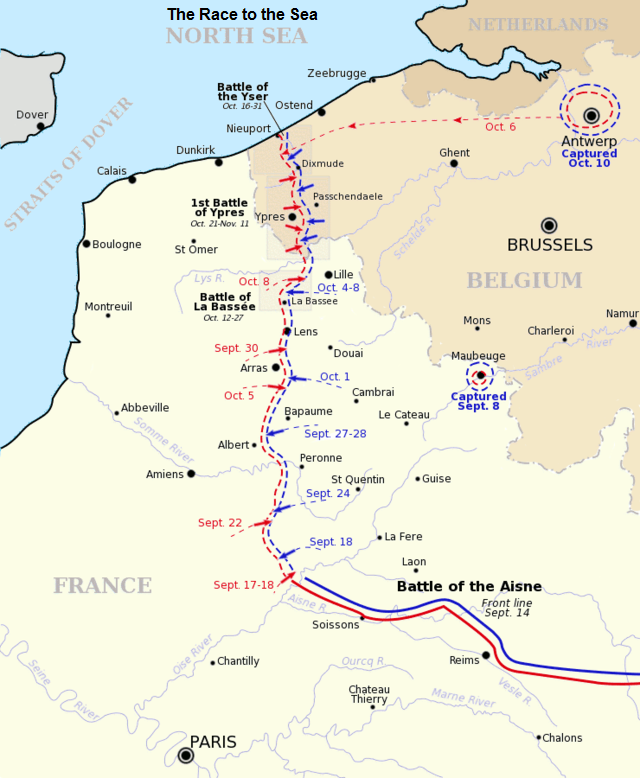
After the first battle of the Aisne 7 and 9 Field Companies advanced north with the 4th Division to Flanders in Belgium
Elements of 7 Coy arrived on the southern edge of the wood on the 16-17 October 1914 when they were in support of 12 Inf Bde who were clearing the enemy from Le Gheer, Le Touquet village ,Le Bizet, Armentieres and Houplines. 1 & 2 Sections dug trenches and put up entanglements near Le Touquet . 3 & 4 Sections worked on trenches and entanglements near Le Gheer.
By the 20th October most of the Sections were working in Ploegsteert Wood. These were early days in the B.E.F’s tenancy of the Wood. 1 & 2 Sections worked on trenches at the St Yves sector, digging trenches and erecting wire entanglements.
From the 24 October the Company employed civilian labourers to work on second line trenches.
30 October 1, 2 & 3 Sections were working on entanglements for 11th Bde. The Germans made strong attacks on 4 Division’s positions, 2 Section were shelled while working on the trenches, fortunately there were no casualties. On this date No 4 Section was supporting 12th Bde and billeted in Nieppe.
By the 20th October most of the Sections were working in Ploegsteert Wood. These were early days in the B.E.F’s tenancy of the Wood. 1 & 2 Sections worked on trenches at the St Yves sector, digging trenches and erecting wire entanglements.
From the 24 October the Company employed civilian labourers to work on second line trenches.
30 October 1, 2 & 3 Sections were working on entanglements for 11th Bde. The Germans made strong attacks on 4 Division’s positions, 2 Section were shelled while working on the trenches, fortunately there were no casualties. On this date No 4 Section was supporting 12th Bde and billeted in Nieppe.
The majority of work was in and around Ploegsteert Wood, the main work at this time consisted of:
Trench work, breastworks, wire entanglements, tracks and pathways, supervising civilian labour on second line trenches, canvas roofed huts and shelters, loop holes in
ruined buildings, demolitions of ruined buildings, drainage, timber yard and workshop in Armentieres, repairing water pumps, replacing girder bridge in L’Attergatte,
and Tunnelling Company under command of the Company.
Trench work, breastworks, wire entanglements, tracks and pathways, supervising civilian labour on second line trenches, canvas roofed huts and shelters, loop holes in
ruined buildings, demolitions of ruined buildings, drainage, timber yard and workshop in Armentieres, repairing water pumps, replacing girder bridge in L’Attergatte,
and Tunnelling Company under command of the Company.
On the 5th October 1914 the Company left the area and marched for several days before boarding a train to Blendecques where they detrained and over the next few days they marched to Hondeghem, Caestre, Metcren, Bailleul,Nieppe and Ploegsteert doing jobs at some of the locations. 1915 would see the Company working mainly in the Armentieres-Nieppe- Ploegsteert-Zillebeke-Poperinghe-Sanctuary Wood areas.
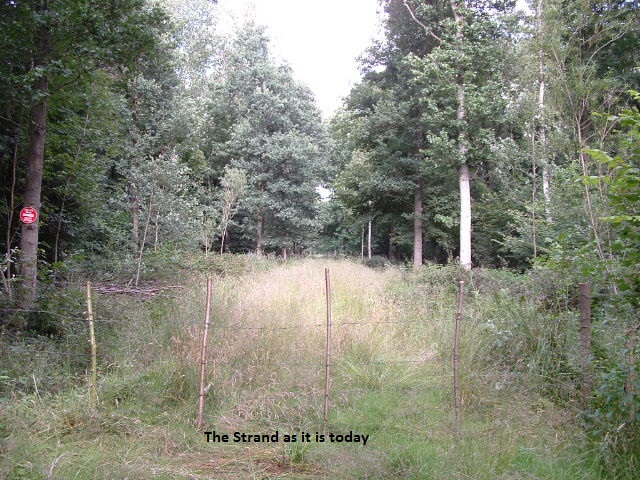
The Strand as it is today
Ploegsteert Wood: Second Line trenches October 1914, quite possibly built
by 7 Field Company
by 7 Field Company
Corderouy path in Ploegsteert Wood 1914. This could be the work of 7 Field Company
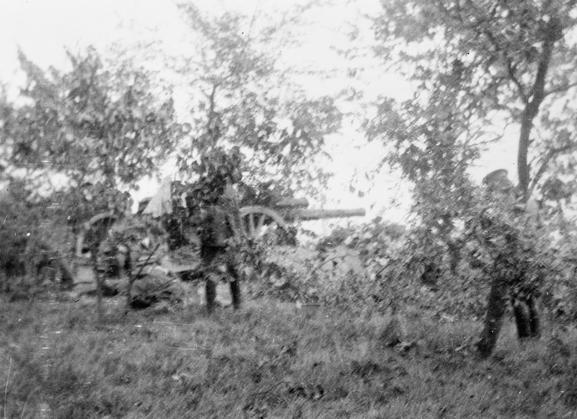
British 60 pounder in Ploegsteert Wood 19-20 October 1914
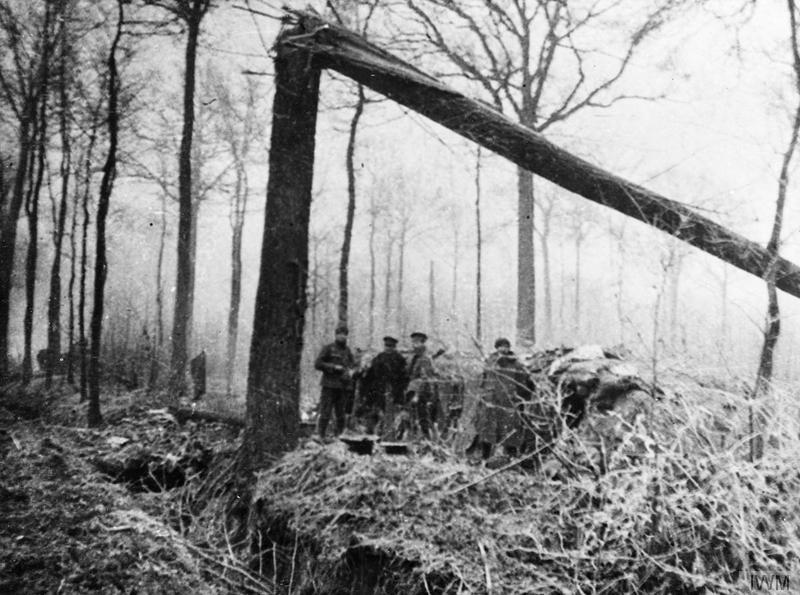
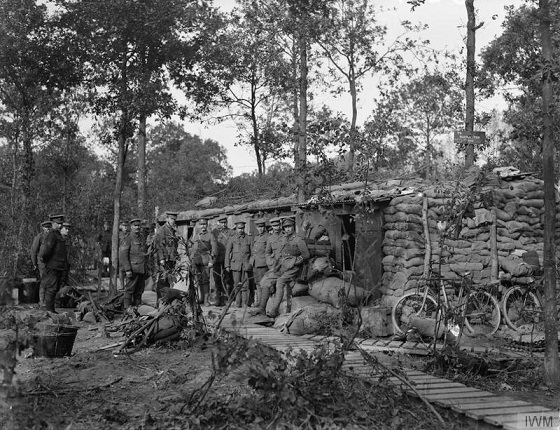
RE photo. British troops outside a shelter in Ploegsteert Wood October 1915
3 Section and attachments built this bridge at L'Attergatte Armentieres in November 1914
7 Field Company witnessed the Christmas Carol exchanges in the trenches between Friend and Foe on Christmas Eve 1914
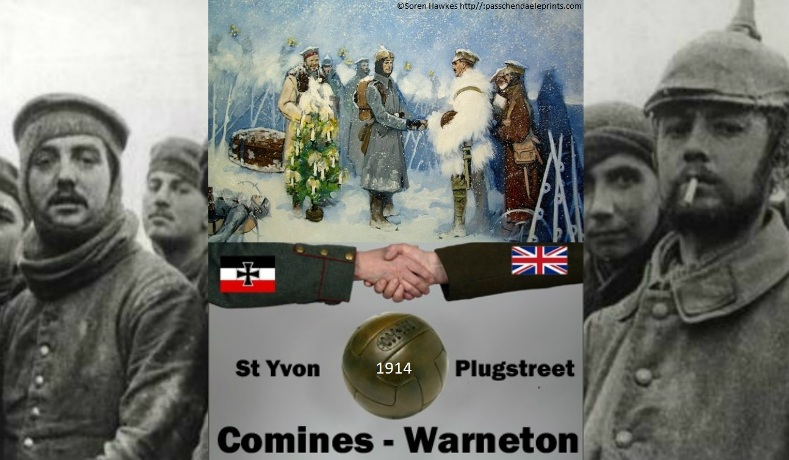
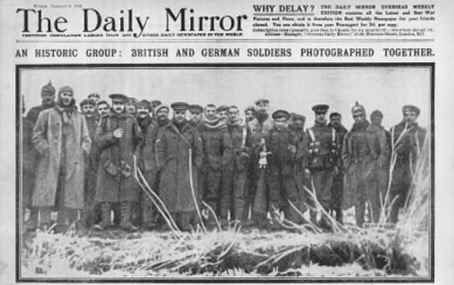
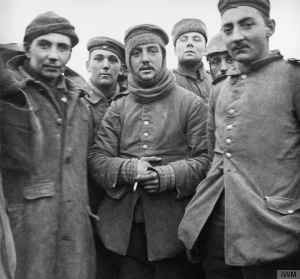
Centre de Poitiers 7 Coy's HQ trench location
May 1918
May 1918
Centre de Poitiers
5 Men of 7 Field Company are commemorated at Soissons Memorial to the Missing
Spr T. Clarkson All were Killed in Action 27 May 1918
Spr W.T. Denham
Spr W.C.T. Moses
CSM H.F. Parker
SGT T.B. Pinnegar
Spr T. Clarkson All were Killed in Action 27 May 1918
Spr W.T. Denham
Spr W.C.T. Moses
CSM H.F. Parker
SGT T.B. Pinnegar


Breast Works in Ploegsteert Wood October 1914
| Dvr A. Hawkins 4 November 1914 |

7 Field Company Roll of Honour 1914

The Black
Horse
Horse
The Black
Horse
Horse
Five men of 7 Field Company are commemorated at this Memorial. They were killed on the 27 May 1918
when the Germans sprung a massive surprise attack on their positions where they had recently moved to for rest.
Sapper 178254 Tom Clarkson 27/5/1918
Sapper 486368 William Thomas Denham 27/5/1918
Sapper 48528 William Charles Joseph Moses 27/5/1918
CSM 12820 Herbert Frank Parker 27/5/1918
Sgt 11901 Theodore Bertram Pinnegar 27/5/1918
when the Germans sprung a massive surprise attack on their positions where they had recently moved to for rest.
Sapper 178254 Tom Clarkson 27/5/1918
Sapper 486368 William Thomas Denham 27/5/1918
Sapper 48528 William Charles Joseph Moses 27/5/1918
CSM 12820 Herbert Frank Parker 27/5/1918
Sgt 11901 Theodore Bertram Pinnegar 27/5/1918
50th Divisional area May 1918
While we were at Soissons we visited the area where 7 Field Company were in May 1918 with 50 Division, 149 Bde when the Division
was wiped out by a massive surprise attack.
While we were at Soissons we visited the area where 7 Field Company were in May 1918 with 50 Division, 149 Bde when the Division
was wiped out by a massive surprise attack.
The Xmas Truce History Channel Documentary
https://www.youtube.com/watch?v=StL2F_Y91mk
https://www.youtube.com/watch?v=StL2F_Y91mk
Chris Ellis a 1960s veteran of
7 Field Squadron RE, visits
Venizel bridge 100 years after
7 Field Company worked here with 9 Field Company building and maintaining a pontoon bridge over the River Aisne in September 1914
7 Field Squadron RE, visits
Venizel bridge 100 years after
7 Field Company worked here with 9 Field Company building and maintaining a pontoon bridge over the River Aisne in September 1914